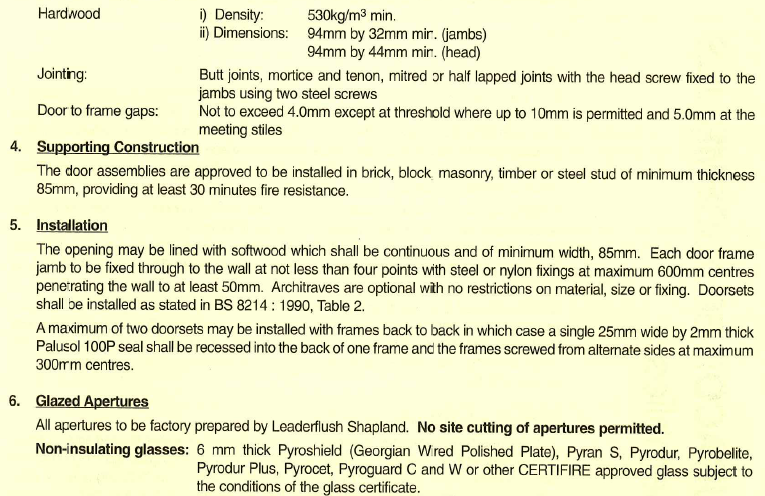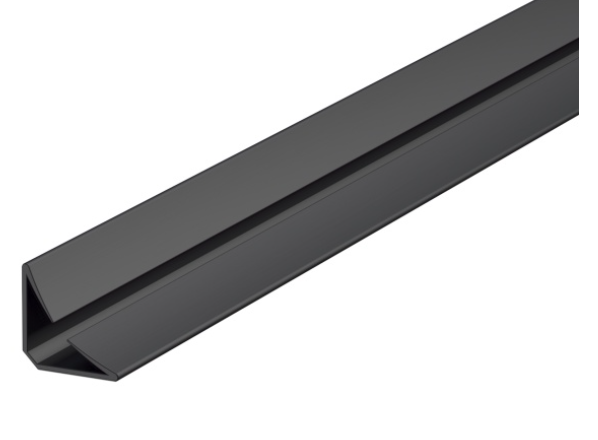-
Posts
505 -
Joined
-
Last visited
Everything posted by Neil Ashdown MAFDI
-
From your description regarding the hinge fixing points AND the door being cracked, it may be better to replace the door. Without seeing the full extent of the defects its impossible to be more specific.
-

space between fire door frame and opening
Neil Ashdown MAFDI replied to a topic in Fire Doors and Accessories
The issue with using plywood for lining the structural opening or adding to the back of the door frame could be one of supporting evidence. What you say (above) may well be reasonable but you may need supporting evidence from the door manufacturer to satisfy your client. Best to stick with the British Standard and door manufacturers installation data sheet because that evidence is clearly demonstrable. -

Reducing gaps between door and frame
Neil Ashdown MAFDI replied to a topic in Fire Doors and Accessories
The issue for the many building operators that have Fire Doors manufactured by Leaderflush Shapland is that they must still maintain those doors to meet fire safety regulations. Clearly these doors will have been installed some years ago and as this manufacturer is no longer in business the certification and data sheets for the doors are no longer available from the website of the third party certification company. However where those records are archived, the data sheet can be referenced to assist with inspections, maintenance and repairs. For example certificate data sheet CF113 (see excerpt attached) from the year 2007 is clearly no longer valid but the door in question would have been manufactured and installed of its time, therefore this is the correct document to use for maintenance and repair purposes - so there's your proof! What Sean says would be correct in a scenario where a door supplier was attempting to market for sale new fire doors using that out of date certification, but clearly not where somebody is carrying out maintenance and repairs to an old fire door that bears the matching certification label! -

space between fire door frame and opening
Neil Ashdown MAFDI replied to a topic in Fire Doors and Accessories
A gap of 8mm to 10mm between the edge of the door leaf and the latch keep is excessive. Maybe the latch keep has been overly recessed into the door frame, you don't say and haven't provided a photograph? If so it should be possible to remove the latch keep and repair that section of the door frame so that the keep can be reinstalled with a tighter gap. -

Reducing gaps between door and frame
Neil Ashdown MAFDI replied to a topic in Fire Doors and Accessories
Hi Sean, At face value your statement appears to be misleading and, in view of the possibly thousands of buildings containing Leaderflush Fire Doors, needs clarification about the circumstances in which the doors would be a "fail in a court of law"! -

Fire and Smoke Seals in door stops
Neil Ashdown MAFDI replied to LEZC's topic in Fire Doors and Accessories
Intumescent fire seals can only be fitted in the door frame reveal or the door leaf edges but there are smoke seals that are designed to fit to the rebate stop of the door frame so that the door leaf closes on to them to compress the fin so as to provide a seal between the door leaf and door frame. -

space between fire door frame and opening
Neil Ashdown MAFDI replied to a topic in Fire Doors and Accessories
Use of a continuous (length and width) timber subframe is acceptable so long as it meets the requirements of BS 8214: 2016 so the subframe, doorframe, linear gap and the sealing of that gap should be as shown in section 9.4.2. The material of the subframe should be the same as the door frame, eg: softwood for FD30 and hardwood for FD60. -
These days most flat entrance doors have a three point locking system for enhanced security but in years past its quite normal to find a mortice sash-lock or a cylinder rim night latch - and sometimes both. There are issues with the use of cylinder rim night latches due to the positioning of the lock so far up the height of the door and because of the large hole required for the cylinder. All flat entrance doors that are fire doors must have an effective self-closing device.
-

FD 30 door replacement mandated?
Neil Ashdown MAFDI replied to Paulgiv's topic in Fire Doors and Accessories
It is not absolutely necessary to identify a fire door to particular fire resistance performance certification, so it would be interesting to see the fire door inspection report from the 'company'. This latest Government guidance might be helpful https://assets.publishing.service.gov.uk/government/uploads/system/uploads/attachment_data/file/1147631/A_guide_to_making_your_small_block_of_flats_safe_from_fire.pdf Flat entrance doors are covered from page 19 onwards. -

space between fire door frame and opening
Neil Ashdown MAFDI replied to a topic in Fire Doors and Accessories
Referencing BS 8214: 2016 section 9.4.2 in respect of your questions: Q1) Should an Intumastic water based acrylic sealant being used to seal the gaps between fire door frame and wall have supporting test evidence to validate its use between a timber stud wall and FD30 fire door frame, or would testing to any linear gap such as floor to wall etc be valid? A1) It should have test evidence as referenced in 9.4.2 including note 4 and used as illustrated in Tables 2 to 5. Q2) BS 8214:2016 Clause 9.4.2 Note 4 advises that it should be tested to the application it’s being used in, and I assume this would also mean gap width and depth would also be tested for its performance. A2) The key point is that it should be used as illustrated in Tables 2 to 5. Therefore the test evidence should be checked for suitability. Q3) Could any fire rated mastic be used or is it a requirement for it to have been tested for use with a fire door frame and supporting structure? A3) The mastic should be as described in 9.4.2 including Note 1 and Note 4. -
As I said no installation instructions provided specific to a fire door and no BS or EN Construction Products Regulations markings on the product or its packaging. So nothing apparent to be able to link the Declaration of Performance, they provided, to the product. It would, as a minimum, be necessary to obtain and carefully study the 'relevant' fire resistance test report before considering whether (and how) to install.
-
No CE / UKCA marks on the product or in the packaging and no specific installation instructions pertaining to fire doors. However, the supplier has provided a Declaration of Performance which references fire resistance testing and use of intumescent material.
-
CF 807 available at https://www.falconpp.co.uk/media/15948/cf807-falcon-panel-products.pdf provides details of the intumescent seal requirement for various door configurations and seal types on pages 5 & 6 of the data sheet. There is further technical data for Strebord fire doors and intumescent seal requirements at https://falcon-timber.com/downloads/
-
"Also interested to see that they don't specify a gap tolerance for the bottom of the door. Historically I've seen 8-10mm as acceptable but this document says "gaps at the bottom of the doors should be as small as practicable" Any thoughts on that one". The code of practice for timber-based fire doors BS 8214 requires a 3mm maximum threshold gap for doors that are required to provide restricted smoke spread, otherwise for a flexible seal to be installed to seal the gap. Generally, in terms of fire resistance performance most fire door manufacturers require the gap to be 8mm to 10mm max. The UK Gov guidance appears to be suggesting a pragmatic approach.
-

Fire doors in a domestic 3 storey house
Neil Ashdown MAFDI replied to a topic in Fire Doors and Accessories
For current building regulations refer to Approved Document B Fire Safety https://assets.publishing.service.gov.uk/government/uploads/system/uploads/attachment_data/file/1124733/Approved_Document_B__fire_safety__volume_1_-_Dwellings__2019_edition_incorporating_2020_and_2022_amendments.pdf Appendix C deals with fire doors -

Reducing gaps in FD30s door
Neil Ashdown MAFDI replied to Member 487327's topic in Fire Doors and Accessories
The 2mm to 4mm gap requirement in BS 8214: 2016 refers to the gap between the edge of the door leaf and the inside face of the door frame. Therefore, in order to resolve a larger gap at the closing edge it would be necessary to loosen/remove and re-position the door frame closing jamb. The smoke seal, in order to be effective, should completely seal the gap when the door is closed. -

Fire doors in a domestic 3 storey house
Neil Ashdown MAFDI replied to a topic in Fire Doors and Accessories
Three storey house? If so a compartment wall and fire door would be required to make the stairs a protected route for escape from the upper floors. -
Regulations are not so specific as to deal with a door knocker/ornament in terms. However, the fire doors must be maintained as adequate to provide sufficient fire and smoke protection to keep relevant persons safe from the effects of fire. Whether or not the knocker/ornament is suitable for fitting to a fire door would be a matter for a fire door specialist.
-

Can a Fire Door Inspector sign off the work?
Neil Ashdown MAFDI replied to Fiona's topic in Fire Doors and Accessories
Although not specifically mandated, it would be good practice for a competent person to inspect the new fire doors and the installation works for compliance with the relevant standards. Otherwise, how do you know they are suitable and adequate to provide the necessary fire & smoke protection? Guidance from HM Gov for fire safety in residential buildings can be found here https://www.gov.uk/government/collections/fire-safety-legislation-guidance-for-those-with-legal-duties#guidance-for-residential-buildings-under-the-fire-safety-order -
Section 2 of this HM Gov guidance document https://assets.publishing.service.gov.uk/government/uploads/system/uploads/attachment_data/file/1147631/A_guide_to_making_your_small_block_of_flats_safe_from_fire.pdf covers the responsibilities of those that own/manage small blocks of flats. Note that fire safety legislation requires a suitable and sufficient Fire Risk Assessment to be carried out and kept up to date. Checking the adequacy of the fire doors is part of that Fire Risk Assessment and the document provides guidance on this matter. Refer to page 25 for HM Gov guidance about inspection & maintenance of fire doors.
-
Building or Fire Safety?
-
Yes indeed Mike, and compliant with what?
-
I have seen similar situations in care homes. Some FD60(s) and another FD30(s) with no apparent reason for the difference in door specification. So where FD60(s) doors have been fitted, surely the question would be: 'Is the added fire resistance that these doors have, any material benefit in terms of the safety of the persons at the building and the safety of the fire services entering the building?'
-
ADB Annex C Fire Doors states: But clearly the most recent fire risk assessment should provide details of the fire rating required given the specific risk to life safety, the fire strategy and access for fire fighters.
-

Fire door Frame thickness and Seal question
Neil Ashdown MAFDI replied to TONY74's topic in Fire Doors and Accessories
Its most likely that because these are double-leaf doors, the fire resistance performance test included wider intumescent seals at the top edge to mitigate the effects of the extra width (eg. two leaves rather that one) at a point where the intensity of the heat is greater (eg. heat rises and risk of failure would likely be at the top edge and meeting edges). The doors would be manufactured to the same specification as those that were fire tested.






